|
Submitting Files For Print
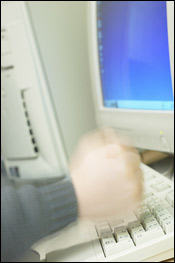 We've learned that by streamlining the prepress process we are able to pass significant savings onto our customers. Our prepress guidelines also let us bypass common pitfalls associated with preparing digital artwork for print such as embedding fonts, and unlinked images. We've learned that by streamlining the prepress process we are able to pass significant savings onto our customers. Our prepress guidelines also let us bypass common pitfalls associated with preparing digital artwork for print such as embedding fonts, and unlinked images.
With quality in mind, we request that all files sent for print be in industry standard formats. We request formats that aren't dependent on the application, fonts or other separate design elements used to create the piece. We accept the following file formats:
TIF - JPG - PDF - EPS - PSD
We can accept Quark, Pagemaker, Corel Draw, or any similar files by converted them to industry standard graphic formats such as TIF, JPG, or PDF. Instructions on how to convert are included below.
Tips for quality output - What to know before you print...
Please read these guidelines very carefully! Although we check all of our customer files for problems, we are not responsible for customers that submit incorrect artwork. To insure proper output, please follow all guidelines and use our templates! If you have any questions regarding your files, please contact our customer care center.
Resolution
We are a high resolution printer so we require all submitted files to be 300dpi (Dots Per Inch). If you design a job at 72dpi or lower we cannot use the file. Our prepress will resize it to 300dpi therefore "stretching" the image out. See the example below where one image was created at 300dpi, the other was created at 72dpi and then stretched out to 300dpi.
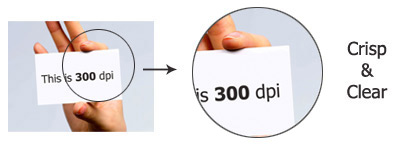 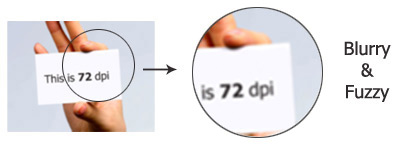
Bleed, Trim & Safety
Bleed
About 1/8” on all sides will be trimmed off. Everything that extends past the original canvas size is considered a bleed. Make sure you do not have any important content in this area. Adjust your canvas size to compensate for this; allow another 1/8”. (See Size)
Although our cutting staff is extremely precise, we can not guarantee any print job cuts with out the added bleed. There are no exceptions. Also, please keep your text at least 1/4" away from the edge of the piece unless it is an eighth page or smaller. This way your text is in a "safe" area. If you have any questions regarding this policy you may call us, or use our design templates located on our website.
Trim
The trim area is a space of 1/8" after the bleed. Its purpose is to separate any text or important content from the edge.
Safety
The safety area is the space where its "safe" to put your layout, design and content.
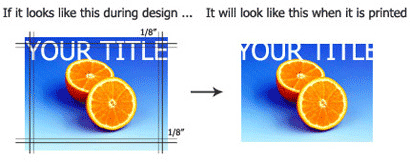
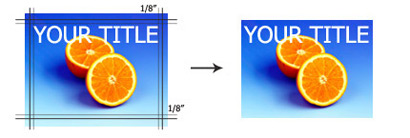
Size
Your print files should be designed in the size that is being ordered. We assume that you desire what you have ordered, and files will be re-sized in accordance to the job. We will not stretch and enlarge a file unless at your request. For example a 4.25"x5.5" quarter page ordered as a 4"x6" postcard will print as a 4"x6".
Borders
If your job is requires a border, please note that in order to have your border exact, we recommend at LEAST a minimum of .25" on all sides. Our cutters are specialists in their field, however due to paper shift, we can not guarantee it would be exactly balanced on all sides.
Color
There are two types of color spaces that are used for graphic and print design:
RGB
(Red, Green, Blue) These are the colors your monitor uses to display everything.
CMYK
(Cyan, Magenta, Yellow, Black) These are the colors used for printing.
Color shifts are usually not visible in color photographs; however, rich and solid colors (like a background) can be affected by a color conversion. Most of the time, color shifts are minor and may not be noticeable.
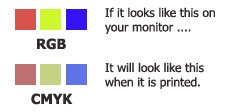
Using the color BLACK
Rich Black
Large, solid black areas and text over 36 points should use Rich Black to prevent the color looking gray. Rich Black consists of 30% Cyan, 30% Magenta, 30% Yellow, 100% Black. For regular body text, do not use Rich Black.
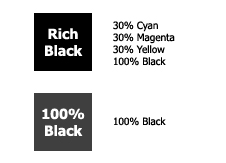
4 Color Build Black
If you have small, thin text on your piece, it is STRONGLY recommended that you do not use 4-color build black on your piece. Although, using a 4-color black is recommended on larger areas, using 4-color text on small areas will make your text blurry and at times, unreadable.
Process printing uses 4 plates that overlay to make your full color spectrum on your paper. Although precise, the registration of the 4-plates will shift during the print process. If you use all 4 colors to create your black, they will not line-up precisely, creating a ghosting affect.
This is especially evident on small text, or small lines 12pt and smaller. In order to fix this, we require that all small text be created as 100% black, 0% Cyan, Magenta, Yellow. This way, as plates shift, it will not affect the black color.
Please view this picture for an example.
Fonts
Convert fonts to paths when possible. By converting fonts to paths in programs like Illustrator and FreeHand, you will avoid having to send the fonts with your files. When converting to paths, the text becomes a vector shape and will look no different than its original state.
In Photoshop, text can be rasterized and therefore does not need the fonts. Keep in mind that after pasteurizing text, no changes can be made to the text.
If your fonts are not converted to paths or rasterized, your design may not be viewed the way it was meant to be seen.
File Names
In order to make the preflight process more efficient, please use unique file names for files you are submitting. The file name should reflect the job name that was given when ordering. Example: jsmith_4x6_front.pdf
Image on Both Sides
Let us know during the ordering process if you want your project printed with the same image on both sides. If we are not notified early in the project and receive only one file, your project could be delayed in order to locate the second file. If we receive two of the same file, your project could be delayed until you verify that both sides are to be printed with the same image.
Instructions For Exporting From Design Programs
Quark Xpress®
- From the file menu in Quark select: "Save page as EPS..."
- Name the file and press "Save".
- Open the Quark EPS file into Adobe Illustrator, "Select All" and go to the "Type" menu selection and "Create Outlines". All text on files must be converted to outlines with the outline set to zero to eliminate the need for fonts.
- Save file as Illustrator EPS with placed images included.
- Open Illustrator EPS file into Photoshop.
- In Photoshop set resolution to 300 dpi and mode to CMYK.
- Save files as "JPEG" or "TIF" with Maximum quality.
Freehand®
- Go to "Edit"; "Select"; "All" and then go to the menu selection "Text" then "Convert to Paths". All text within files must be converted to paths with the stroke set to zero to eliminate the need for fonts to be sent to us.
- Export file as EPS with placed images included.
- Open EPS file into Photoshop.
- In Photoshop set resolution to 300 dpi and mode to CMYK.
- Save files as "JPEG" or "TIF" with Maximum quality.
Adobe Illustrator®
- In Illustrator "Select All" and go to the "Type" menu selection and "Create Outlines". All text within files must be converted to outlines with the outline set to zero to eliminate the need for fonts.
- Save file as Illustrator EPS with placed images included.
- Open Illustrator EPS file into Photoshop.
- In Photoshop set resolution to 300 dpi and mode to CMYK.
- Save files as "JPEG" or "TIF" with Maximum quality.
|